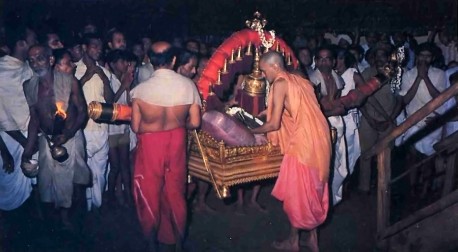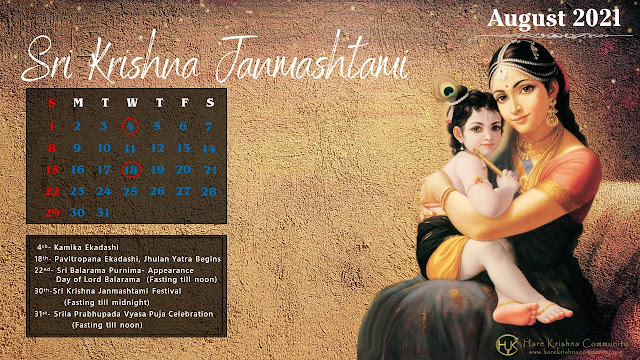This is a song sung by Narottama dāsa Ṭhākura. He says, "When that day will come, that I shall sing simply Lord Caitanya's name and there will be shivering on my body?" Gaurāṅga bolite habe pulaka-śarīra. Pulaka-śarīra means shivering on the body. When one is factually situated in the transcendental platform, sometimes there are eight kinds of symptoms = crying, talking like a madman, and shivering of the body, dancing without any care for any other men... These symptoms develop automatically. They are not practiced artificially.
So Narottama dāsa Ṭhākura is aspiring for that day, not that one has to artificially imitate. That he does not recommend. He says, "When that day will come, so that simply by uttering the name of Lord Caitanya there will be a shivering on my body?" Gaurāṅga bolite habe pulaka-śarīra. And hari hari bolite: "And as soon as I shall chant 'Hari Hari,' or 'Hare Kṛṣṇa,' there will be pouring down of tears from my eyes." Hari hari bolite nayane ba'be nīra. Nīra means water. Similarly, Caitanya Mahāprabhu also said that "When that day will come?" We should simply aspire. But if, by Kṛṣṇa's grace, that stage we can reach, these symptoms will come automatically. But Narottama dāsa Ṭhākura says that it is not possible to reach that stage without being freed from material affection.
Therefore he says, āra kabe nitāi-cander, koruṇā hoibe: "When that day will come when Lord Nityānanda's mercy will be bestowed upon me so that..." Viṣaya chāḍiyā Āra kabe nitāi-cander koruṇā hoibe, saṁsāra-bāsanā mora kabe tuccha ha'be. Saṁsāra-bāsanā means the desire for material enjoyment. Saṁsāra-bāsanā mora kabe tuccha ha'be: "When my desire for material enjoyment will be insignificant, nonimportant." Tuccha. Tuccha means a thing which we calculate no value = "Throw it away." Similarly, spiritual advancement is possible when one is convinced that "This material world and material happiness is no value. It cannot give me any real bliss of life."
This conviction is very much necessary. Saṁsāra-bāsanā mora kabe tuccha ha'be. And he also says that "When I shall be free from the desires of material enjoyment, then it will be possible to see the real nature of Vṛndāvana." Viṣaya chāḍiyā kabe śuddha ha'be mana: "When my mind will be completely purified, uncontaminated from the material contamination, at that time it will be possible for me to see what is Vṛndāvana." In other words, one cannot go to Vṛndāvana by force and live there, and he will achieve that transcendental bliss. No. One has to make his mind freed from all material desires. Then one can live at Vṛndāvana and relish its residential benefit. So Narottama dāsa Ṭhākura says that. Viṣaya chāḍiyā kabe, śuddha ha'be mana: "When my mind will be freed from the contamination of this material enjoyment and I shall be purified, then it will be possible for me to see Vṛndāvana as it is." Otherwise it is not possible.
And he says again that to go to Vṛndāvana means to understand the transcendental pastimes of Rādhā and Kṛṣṇa. How this will be possible? So he says, rūpa-raghunātha-pade hoibe ākuti. Rūpa, Rūpa Gosvāmī, beginning from Rūpa Gosvāmī down to Raghunātha dāsa Gosvāmī, there were Six Gosvāmīs = Rūpa, Sanātana, Gopāla Bhaṭṭa, Raghunātha Bhaṭṭa, Jīva Gosvāmī, Raghunātha dāsa Gosvāmī. So he says, rūpa-raghunātha-pade: "Beginning from Rūpa Gosvāmī down to Raghunātha dāsa Gosvāmī," pade, "in their lotus feet, at their lotus feet. When I shall be eager to be attached at their lotus feet..." Rūpa-raghunātha-pade, hoibe ākuti. Ākuti, eagerness. What is that eagerness? That means to understand Rādhā-Kṛṣṇa through the guidance of the Gosvāmīs.
One should not try to understand Rādhā-Kṛṣṇa by his own effort. That will not help him. As these Gosvāmīs, they have given us direction, just like Bhakti-rasāmṛta-sindhu, so one has to follow step after step how to make progress. Then there will be a fortunate day when we shall be able to understand what is the pastimes or loving affairs between Rādhā and Kṛṣṇa. Otherwise, if we take it as ordinary boy and girls reciprocating their loving feelings, then we will misunderstand. Then there will be the production of prakṛta-sahajiyā, victims of Vṛndāvana.
So Narottama dāsa Ṭhākura is giving us the direction, how one can reach the highest perfectional stage of associating with Rādhā and Kṛṣṇa. The first thing is that one should be very much attached to Śrī Caitanya Mahāprabhu. That will lead us. Because He came to deliver the understanding of Kṛṣṇa consciousness, therefore one should first of all surrender to Śrī Caitanya Mahāprabhu.
By surrendering to Śrī Caitanya Mahāprabhu, Nityānanda Prabhu will be pleased, and by His pleasing, we shall be freed from material desires. And when material desires are no more, then we shall be able to enter Vṛndāvana. And after entering Vṛndāvana, when we are eager to serve the Six Gosvāmīs, then we can reach the platform to understand the pastimes of Rādhā and Kṛṣṇa. Yes. [end]









